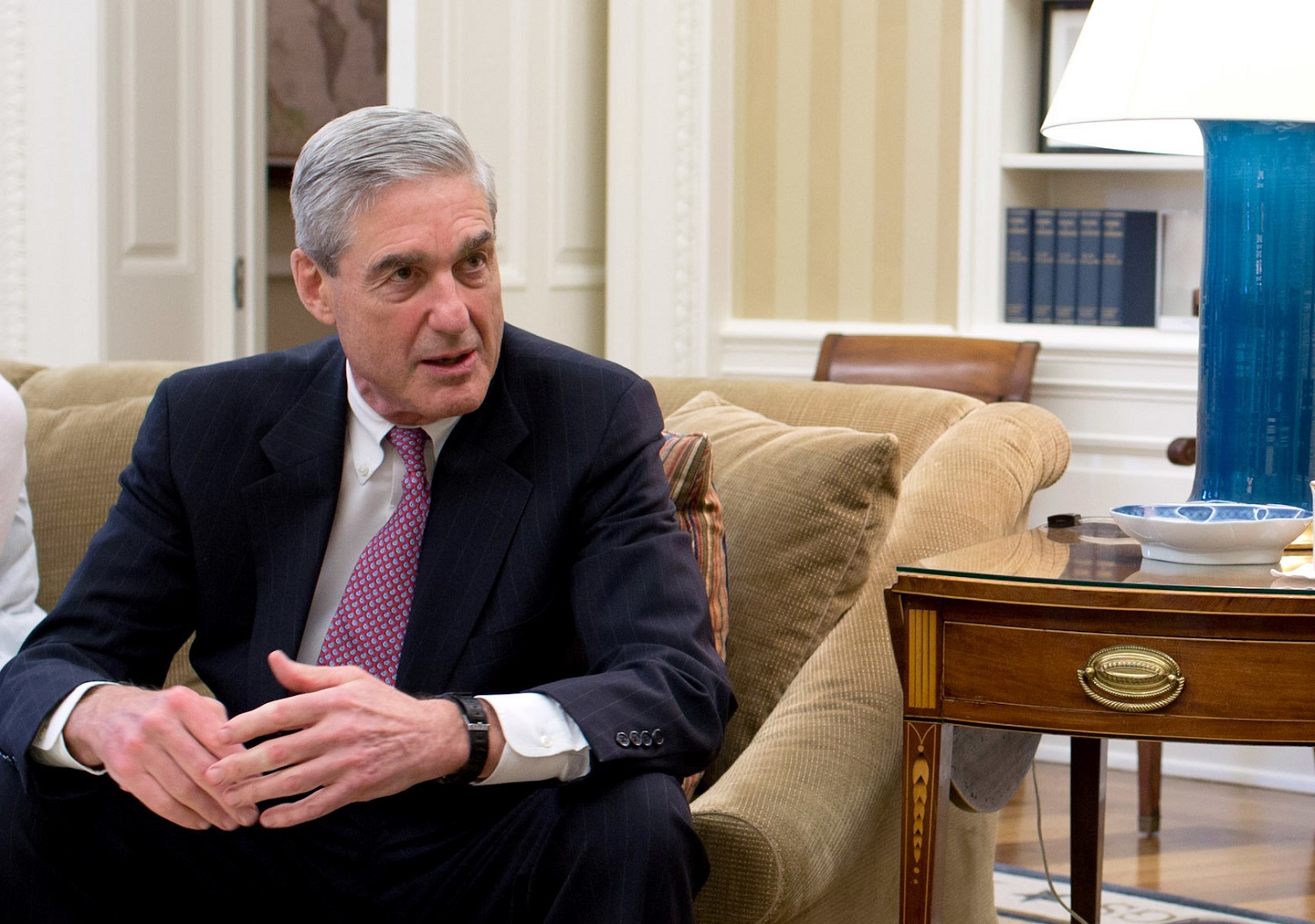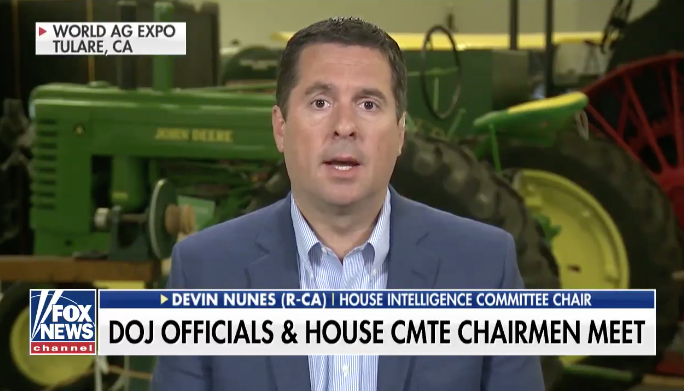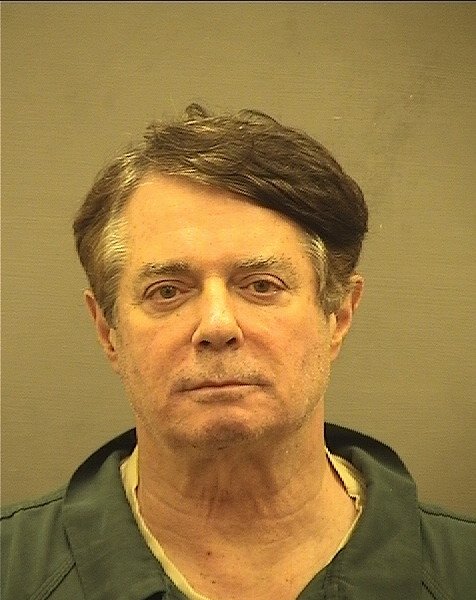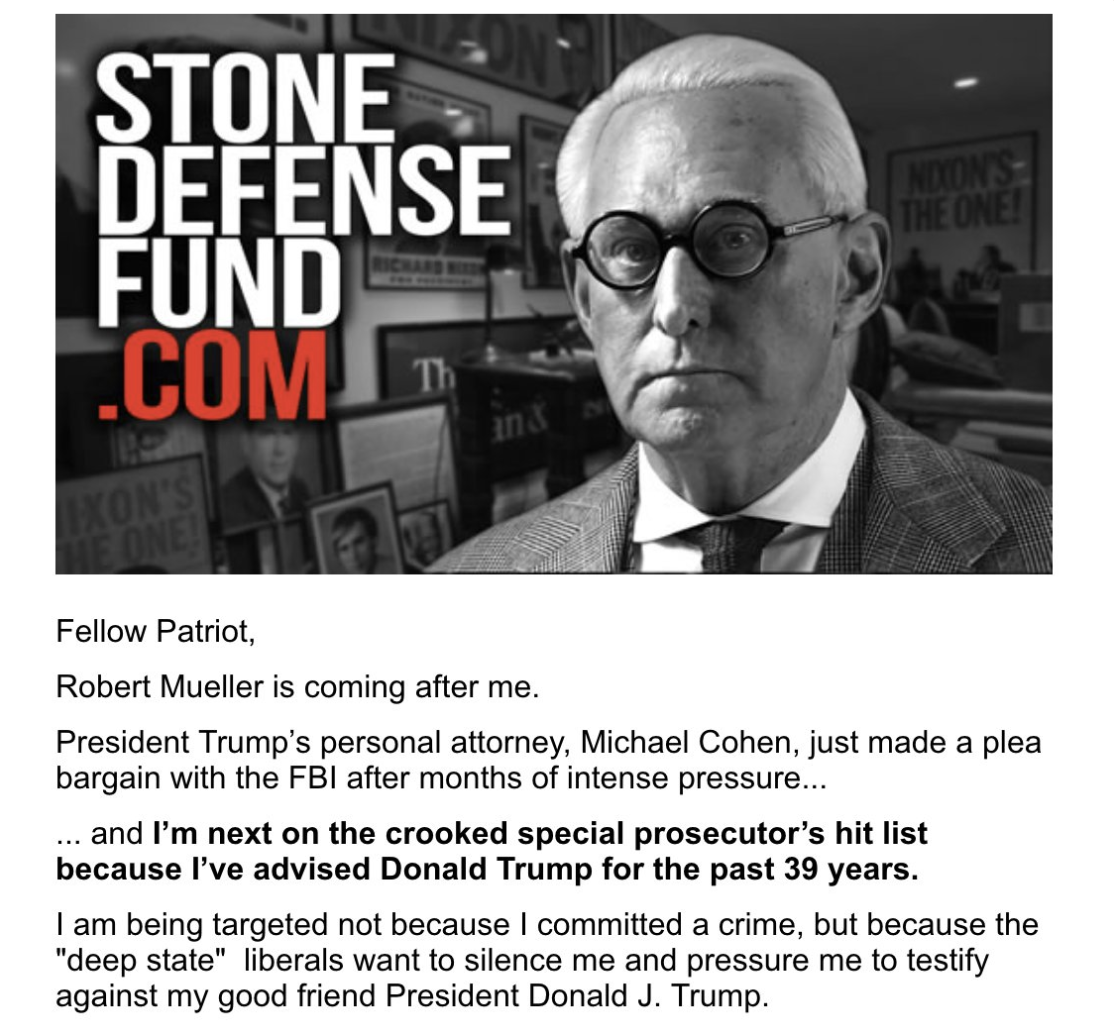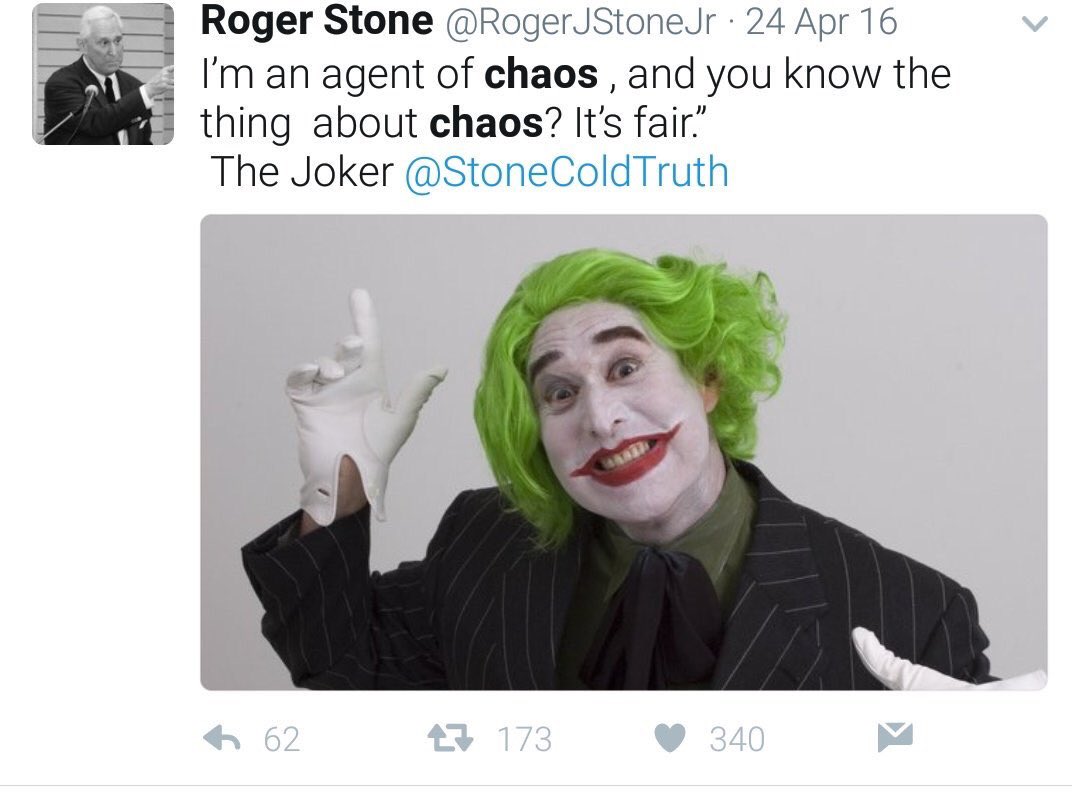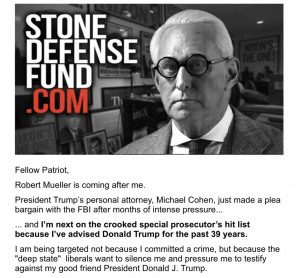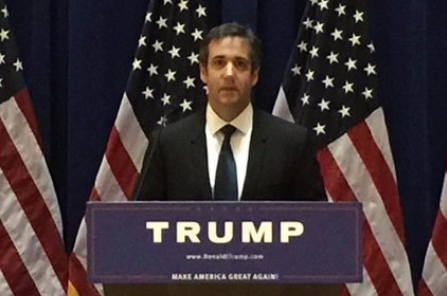Before you answer, “no,” hear me out.
I’ve been obsessing about what else — besides repeatedly entertaining offers of help from Russians and changing his opinion about whether Russia hacked the DNC on a dime and thereafter magnifying propaganda that helped Russia’s plausible deniability, even while claiming some knowledge of it — Mueller is investigating Roger Stone. The subpoena challenge of his sometime assistant, Andrew Miller, makes it clear that at least part of the investigation focuses on Stone’s dodgy 527 and PACs. I’ve shown how the second (general election) incarnation of Stone’s Stop the Steal 527 engaged in voter suppression that paralleled the efforts Russia was making.
But we know from the reports of witnesses, including Michael Caputo, that Mueller’s interest in Stone’s activities go back before the general election. For example, he’s interested (in the wake of Rick Gates signing a cooperation agreement) in meetings Stone had with Gates. According to Stone, the only meeting he had with Gates during the election happened shortly after April 19, 2016; Gates was there because Manafort had to cancel at the last minute.
“I only have a record of one dinner with Rick Gates,” he said, adding that the guest list included two other political operatives: Michael Caputo, a former Trump campaign aide who was recently interviewed by Mr. Mueller’s investigators, and Paul Manafort, who soon after took over as chairman of Mr. Trump’s campaign. But Mr. Manafort canceled at the last minute, and Mr. Gates, his deputy, attended in his place.
Mr. Stone said the conversation during the dinner, which fell soon after the New York primary in April 2016, was about the New York State delegate selection for the Republican National Convention. The operatives expressed concern about whether delegates, at a time of deep division among Republicans, would be loyal to Mr. Trump’s vision for the party, Mr. Stone said.
The suggestion, then, is that Mueller’s star witness, Rick Gates, told the special counsel about Stone and Manafort getting the old gang back together. Which would have started in March, as Manafort was wooing Stone’s longtime associate Donald Trump. During the same month, Stone-style rat-fucking was putting the finishing touches to Ted Cruz’ presidential ambitions. That was precisely the period when former Young Republican John Powers Middleton was loading up Stone’s Committee to Restore American Greatness (from which Stop the Steal would get its initial cash infusion). Stone was tweeting out his Stop the Steal campaign, even if he had not yet registered it with the IRS. And not long afterwards, Russian hackers would still be searching Democratic servers for dirt on Cruz, even after he had been mathematically eliminated.
[O]n or about April 15, 2016, the Conspirators searched one hacked DCCC computer for terms that included “hillary,” “cruz,” and “trump.”
The possibility that Mueller’s interest in Stone (and Manafort) extends back to the primary is all the more interesting given how centrally some of Stone’s core skill-sets played out in the lead-up to the Convention. There were veiled threats of violence (and in the home of his dark money, actual violence), a smear story projecting on Cruz the infidelity more typical of Trump, and lots of money sloshing around.
It’s not entirely clear what crime that would implicate — besides potential campaign finance violations (particularly, given Trump’s repeated disavowals of any coordination between Stone and his old buddy Manafort).
And, given how rabidly Republican base voters support Trump, I could see why Republicans would let bygones be bygones. It’s not like the Republican party has ever before shown distaste for Stone’s rat-fucking. Plus, no one likes Ted Cruz, and he may not even survive his race against Beto O’Rourke. So, no, Republicans won’t be any more disposed against Stone if he is shown to have helped Trump cheat in the primary.
All that said, if Mueller indicts Stone in other crimes that Republicans would like to distance themselves from, any allegations about the primary may provide cover.
So, no, whatever dark money slush Mueller is looking at implicates Trump’s victory over the mainstream party won’t, by itself, turn Republicans against Trump. But down the road it may provide cover for the moment Republicans would like to turn on him.
Timeline
September 2, 2011: Pamela Jensen registers Should Trump Run 527 with Michael D Cohen listed as President
October 1, 2015: Pamela Jensen registers STOP RAPE PAC by loaning it enough money to pay for a mailbox
November 10, 2015: Jensen & Associates loans $2,398.87 to CRAG
November 10, 2015: CRAG pays Entkesis 2373.87
December 17, 2015: Corey Lewandowski disavows CRAG
December 24, 2015: CRAG pays Newsmax 10803.55
December 31, 2015: CRAG pays Newsmax 1585.76
February 1, 2016: Pamela Jensen sends out fundraising letter to World Net Daily pushing Kathleen Wiley’s mortgage fundraiser
February 4, 2016: Jensen & Associates loans $2,610 to CRAG
February 10, 2016: Loans from Jensen & Associates repaid
February 19, 2016: Roger Stone tells Alex Jones that Donald Trump has donated to the Kathleen Willey fundraiser, even though it had raised less than $4,000 at that time
February 29, 2016: Paul Manafort pitches Trump on managing his convention
March 1, 2016: John Powers Middleton Company donates $150,000 to CRAG
March 6, 2016: First tweet in spring Stop the Steal campaign
March 9, 2016: John Powers Middleton donates $50,000 to CRAG
March 11, 2016: John Powers Middleton donates $25,000 to CRAG
March 14, 2016: John Powers Middleton donates $25,000 to CRAG
March 23, 2016: National Enquirer publishes story, quoting Stone, claiming multiple Ted Cruz affairs
March 28, 2016: On recommendation of Tom Barrack and Roger Stone, Trump hires Manafort as convention manager, thereby bringing in “traditional” methods Stone resigned over in 2015
April 5, 2016: Stone threatens to send Trump supporters to disloyal delegates hotel rooms, also claims voter fraud in primaries Cruz won
April 6, 2016: Stone (Sarah Rollins) establishes Stop the Steal in same UPS post box as CRAG
April 6, 2016: CRAG gives $50,000 to Stop the Steal
April 6, 2016: CRAG pays Jensen & Associates $11,000
April 6, 2016: CRAG pays Jensen & Associates $9,000
April 6, 2016: Stone tweets Stop the Steal toll free line to “report voter fraud in Wisconsin” primary
April 8, 2016: Stone accused of menacing after threat of Day of Rage
April 12, 2016: John Powers Middleton donates $60,000 to CRAG
April 13, 2016: Stop the Steal pays Sarah Rollins $386.72
April 14, 2016: CRAG pays Tim Yale $9,000
April 14, 2016: Stop the Steal pays Jim Baker $1,500 in “expense reimbursements for rally”
April 15, 2016: GRU hackers search “one hacked DCCC computer for terms that included “hillary,” “cruz,” and “trump”
April 15, 2016: Stop the Steal pays Sarah Rollins $500
April 15, 2016: John Powers Middleton donates $15,000 to CRAG
April 15, 2016: John Powers Middleton donates $2,000 to CRAG
April 15, 2016: $1,000 refunded to John Powers Middleton
April 18, 2016: John Powers Middleton donates $1,000 to CRAG
April 18, 2016: CRAG pays Citroen Associates $40,000
April 19, 2016: CNN writes profile on “the Return of Roger Stone”
Shortly after April 19, 2016: Stone and Rick Gates meet in NY.
April 25, 2016: CRAG pays Paul Nagy $2,500
April 25, 2016: CRAG pays Sarah Rollins $500 plus $41.66 in expenses
April 28, 2016: Protest outside of Donald Trump rally in Costa Mesa turns violent
April 29, 2016: John Powers Middleton donates $50,000 to CRAG
May 1, 2016: Last Stone tweet in spring Stop the Steal campaign
May 2, 2016: CRAG pays Sarah Rollins $800
May 2, 2016: Stop the Steal fundraises and calls for march on Convention, even as Trump disavows any tie to it or other PACs/527s
May 4, 2016: CRAG pays Jensen & Associates $5,000
May 13, 2016: CRAG pays Sarah Rollins 93.50
May 15, 2016: Stop the Steal pays Sarah Rollins $500
May 16, CRAG pays Andrew Miller $2,000
May 16, 2016: CRAG pays Citroen Associates $10,000
May 16, 2016: CRAG pays Sarah Rollins $400
May 16, 2016: CRAG pays Kathy Shelton $2,500
May 24, 2016: Stone PAC RAPE PAC, aka Women v Hillary, announced
June 2, 2016: Pamela Jensen sets up Women v Hillary PAC out of a different mailboxes location in Costa Mesa (again, this only ever showed enough money to pay for the mailbox used as its address)
June 7, 2016: FEC informs CRAG it must submit filings by July 12, 2016
June 7, 2016: CRAG pays Jensen & Associates $4,790
June 8, 2016: Stop the Steal pays Paul Nagy $800 in “expense reimbursements for rally”
June 17, 2016: CRAG pays Andrew Miller $3,000
July 5, 2016: CRAG pays Jensen & Associates $14,500
July 6, 2016: CRAG pays Michelle Selaty $10,000
July 6, 2016: CRAG pays Drake Ventures $12,000
July 11, 2016: CRAG pays Cheryl Smith $4,900
July 12, 2016: Stop the Steal gives $63,000 to CRAG
July 12, 2016: CRAG pays Jensen & Associates $7,200
July 15, 2016: CRAG pays Jason Sullivan $1,500
July 18, 2016: CRAG pays Jensen & Associates $7,500
July 20, 2016: CRAG pays Jensen & Associates $3,000
July 29, 2016: CRAG pays Jensen & Associates $6,000
August 1, 2016: CRAG pays Andrew Miller $4,000; Stone flies from JFK to LAX
August 2, 2016: Stone dines with Middleton at Dan Tanas in West Hollywood
August 3, 2016: CRAG pays Jensen & Associates $9,500
August 3, 2016: CRAG pays Josi & Company $2,500
August 3-4, 2016: Stone takes a red-eye from LAX to Miami
August 4, 2016: Stone flip-flops on whether the Russians or a 400 pound hacker are behind the DNC hack and also tells Sam Nunberg he dined with Julian Assange; first tweet in the fall StopTheSteal campaign
August 5, 2016: Stone column in Breitbart claiming Guccifer 2.0 is individual hacker
August 9, 2016: CRAG pays Jason Sullivan $1,500
August 15, 2016: CRAG pays Jensen & Associates $19,500
August 29, 2016: CRAG pays Law Offices of Michael Becker $3,500
August 31, 2016: Robert Shillman gives $8,000 to CRAG
September 12, 2016: CRAG gives $8,000 to Donald Trump
September 14, 2016: CRAG pays $3,000 to Citroen Associates
September 21, 2016: Robert Shillman gives $8,000 to CRAG
September 22, 2016: CRAG gives $8,000 to Donald Trump
October 13, 2016: Stop the Steal pays Andrew Miller $5,000
October 23, 2016: Stone tweets out message saying Clinton supporters can “VOTE the NEW way on Tues. Nov 8th by texting HILLARY to 8888”
October 28, 2016: GRU officer Anatoliy Kovalev and co-conspirators visit websites of counties in GA, IA, and FL to identify vulnerabilities
October 30, 2016: Ohio Democratic Party sues Ohio Republican Party to prevent Stop the Steal voter suppression; Democrats also sue in NV, AZ, and PA
November 3, 2016: Filings in ODP lawsuit describing Stop the Steal (declaration, exhibits)
November 4, 2016: Judge James Gwyn issues Temporary Restraining Order against Trump, Stone, and Stop the Steal
November 4, 2016: Guccifer 2.0 post claiming Democrats may rig the elections
November 7, 2016: Sixth Circuit issues a stay in OH TRO
December 14, 2016: Women versus Hillary gives $158.97 to CRAG
December 19, 2016: Stop the Steal pays $5,000 to Alejandro Vidal for “fundraising expenses”
December 19, 2016: Stop the Steal pays $3,500 to C Josi and Co.
December 21, 2016: Stop the Steal pays $1,500 to The Townsend Group
December 27, 2016: Stop the Steal pays $3,500 to Kristen [sic] Davis
December 28, 2016: Stop the Steal gives $94 to CRAG
December 29, 2016: Stop the Steal pays Jerry Steven Gray $4,000 for “fundraising expenses”
December 30, 2016: Stop the Steal pays 2,692 total to unnamed recipients
January 19, 2017: Stop the Steal pays $5,000 for fundraising expenses to Alejandro Vidal
February 8, 2017: Stop the Steal pays Kristen [sic] Davis $3,500 for “fundraising expenses”
February 15, 2017: Stop Steal pays Brad Boeck $862 for sales consultant consulting fee
As I disclosed in July, I provided information to the FBI on issues related to the Mueller investigation, so I’m going to include disclosure statements on Mueller investigation posts from here on out. I will include the disclosure whether or not the stuff I shared with the FBI pertains to the subject of the post.

